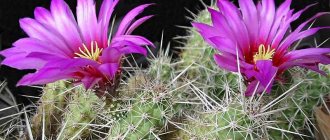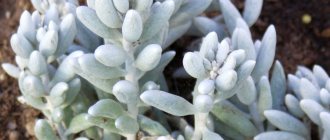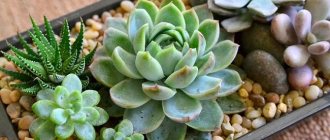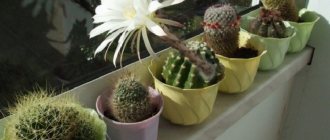Encyclopedia of Succulents
Have you ever dreamed of growing something extremely original and exquisite? If yes, then you definitely need to pay attention to the Espostoa or Espostoya cactus. This incredible plant has a spectacular soft appearance and gives wonderful emotions to everyone who has seen such a bush at least once in their life. Its unusual fluffy stem amazes with its attractiveness and beauty. In this article we will look at the features of growing such a plant and the secrets of caring for it.
- 1 Description of the cactus genus Espostoa
- 2 Caring for cacti of the genus Espostoa 2.1 How to transplant an Espostoa cactus
- 2.2 Difficulties in cultivation
general description
Cacti are a favorite plant of many gardeners, but not many know what the hairy cactus is called and that it even exists. Such a plant is unpretentious in care; it can easily exist in the home of a person who often forgets about watering.
Fluffy cacti
Thanks to the white cloud of hairs, the plant is protected from the scorching rays of sunlight and various pests. The appearance of the succulent makes it stand out from its nondescript counterparts.
Interesting information! One of the first to study this type of succulents was Esposto Nicholas, after whom the fluffy cactus was named.
What does a fluffy cactus look like?
Often Espostoa can be confused with Cephalocereus. This is also a small genus of cacti, including several species of plants, but they branch at the roots and have long and thick light spines, which are much tougher than those of their furry counterpart.
The fluffy cactus has a columnar structure, sometimes with branching stems, which in appearance may resemble a candelabra. The trunk and shoots have a green or gray tint, some types are darker. The plant is completely covered with long white hairs, which grow most abundantly at the top.
Espostoa
Radial spines have a light yellow or red color, usually their length does not exceed 1 cm. The central spines are much longer (can reach 4 cm), differ in color depending on the species.
Cultivation
Some species are grown as houseplants or greenhouse plants, most notably Espostoa lanata. Plants are valued for their unusual appearance. They can be grown both on their own roots and on rootstocks. Cultivated plants bloom very rarely.
Agricultural technology
Plants of this genus require a sunny location and well-drained soil. In summer, fertilizing and sufficient moisture are desirable. In winter, plants need rest, but the temperature should not fall below 12 °C. Reproduction - by seeds.
Main varieties
Queen of the night cactus: main varieties and care options
According to different classifications, espostoa has from 10 to 16 varieties. Miniature species of this cactus are usually grown at home, but large plants can also be found in rare collections. Espostoa cactus differs not only in size, but also in stem color and fluffiness.
Espostoa woolly
Espostoa woolly (lanata) is the most popular variety for breeding at home.
This plant has the appearance of a column, from which up to 30 lateral ribs extend. Under natural conditions, the size of a hairy cactus can reach 5 m, but the indoor plant usually does not grow above 1 m.
Additional shoots appear on an adult plant, due to which the cactus begins to branch far from the base. A larger number of radial needles, which have a yellowish color, break through the wool. The spines can reach 5 cm in length.
Young Espostoa Lanata
Espostoa is amazing
This type of fluffy cactus has an almost white color - it can range from light green to grayish. The diameter of the stem can be 9 cm and the length 0.5 m. In wild conditions, these data also differ, but indoor conditions do not allow the plant to grow much.
The top of the plant is covered with a large number of long white hairs that stick out in different directions. Large areoles with needle-like spines in the center and bristly radial spines are whitish-red in color.
The longer spines are located in the lower part of the plant, which is what distinguishes Espostoa amazing from other species.
Other varieties
Espostoa nana has increased fluffiness, which is combined with the small size of the plant itself. At home, the succulent does not bloom, but some people decide to grow it for the sake of its appearance, which resembles a fur roll.
The shaggy Ritteri cactus is quite long (up to 4 m) with a significant number of dark-colored branches. One column has up to 20 small ribs, which are separated by transverse grooves. The cactus is distinguished by the presence of one central spine, which has a dark color, which can reach 2 cm. The remaining needles have a yellowish or brownish tint, while one Ritteri usually has about 25 spines.
Black-columnar espostoa is considered a rather exotic species. The cactus got its name from its long trunk, reminiscent of a column. The color of the trunk can range from dark green to black. In nature, the height of the plant reaches 2 m.
Black-columnar espostoa
Interesting information! The cactus is almost completely covered with long white hairs that protect it from pests. The plant has 24 ribs, which are completely covered with hairs, but among them you can see brown spines.
Espostoa senilis (senile) is native to Peru. A fairly tall, columnar plant, the white straight spines of which resemble hairs. Radial spines are densely located on the stem, and central ones appear only on mature plants. Flowering occurs only under natural conditions.
Types of indoor espostoa
Most of the espostoa that can be found in indoor format are woolly espostoa (Espostoa lanata), also known as wooly espostoa. This is a powerful cactus that bushes only with age, with the traditional 18-25 ribs, long central spines and white woolly hairs.
Other types of espostoa are considered very rare in indoor collections:
- Blossfeld's espostoa (Espostoa blossfeldiorum) with a yellowish long-haired edge;
- amazing espostoa (Espostoa mirabilis) with lighter stems and hairs sticking out like thick fur;
- thick-haired , with shoots completely hidden under grayish pile,
- dwarf espostoa (Espostoa nana);
- senile espostoa (Espostoa senilis) with very thin, transparent hairs, thanks to which both the ribs and golden spines are clearly visible.
Espostoa are available for sale as both self-rooted and grafted plants.
Particularly popular today are the cristate forms of this amazing cactus (f. cristata), whose stems are intricately branched and divided, creating phantasmagoric coral and comb-like silhouettes.
Amazing Espostoa (Espostoa mirabilis). © Tacuosi
Espostoa senilis. © mld succulents
Espostoa woolly, cristate form (Espostoa lanata f. Cristata). © kaktuszhalom
Flower care rules
With proper care, there will be no problems with the succulent. It is required to choose the plant especially carefully so that it does not have diseases or damage from pests. The trunk should not have soft or loose areas. If the cactus has sparse and fragile hairs, then it is recommended to pay attention to another plant.
Temperature
How often to water a cactus: quantity and options at home
Espostoa is a fairly heat-loving plant, so it feels good only in warm climates. It is recommended to keep the fluffy cactus at a temperature of 17-24 degrees; in the summer, the upper threshold may exceed 30 degrees.
Important! In winter, the plant is in a dormant period, so it is recommended to keep it in a cooler room, where the temperature drops at least 8 degrees. A succulent can get sick if the temperature changes suddenly.
Espostoa in a pot
Sufficient lighting must also be provided. The cactus can be placed on south-facing windowsills, since the hair protects the trunk from thermal burns. But at noon, it is recommended to either shade the plant or open a window so that the supply and exhaust ventilation cools the flower a little. In the cold season, it is necessary to provide the plant with additional lighting.
Humidity
Air humidity is not an important criterion for the growth of shaggy cactus. It is recommended to avoid spraying with water, as this will cause plaque to appear on the hairs, making the plant look untidy.
Watering
The plant does not require frequent watering, since it comes from fairly dry places.
During the active growth phase, it is recommended to water no more than once a week or 10 days. In winter, when the plant is dormant, it is worth reducing water treatments to once a month, since the cactus reacts extremely negatively to large amounts of water and begins to rot.
Important! For irrigation, you must use soft water at room temperature, which must first be well settled.
The soil
You need to make your own soil.
It must be loose enough to allow water to pass through well, otherwise its stagnation will lead to rotting of the lower part of the cactus trunk. You can use a ready-made store-bought substrate, but you need to add a small amount of perlite or vermiculite to it.
The substrate itself is made from peat (2 parts), coarse sand (2 parts), leaf soil (1 part).
There must be a drainage layer at the bottom of the pot.
Top dressing
Fertilizing is required, since in an individual pot, humus quickly becomes salty and becomes poor in nutrients. To avoid burning the roots of the plant, it is recommended to water the soil first.
As a fertilizer, it is worth using special complexes for feeding succulents and cacti.
Fertilizer for cacti
Problems growing?
Espostoa cactus, like all “thorns”, is not difficult to care for.
However, sometimes the furry can be mopey! What are the symptoms? e. woolly
- If Espostoa has dark spots at the base...
Adult cacti are characterized by suberization of the base of the trunk, which is expressed in a change in color - yellowing, darkening. But at the same time the trunk remains solid! If the trunk becomes soft and damp at the base, this is an obvious sign of rotting of the cactus. This happens when the watering regime is violated, to which espostoa are very sensitive. They usually start to rot from the bottom up, so you can try to save the top.
Cut off the rotten part without leaving any residue, powder the cut with ash or charcoal, lightly dry it in air and dust it with Kornevin powder before planting. Place the treated top on the surface of the soil (do not bury it) and wait for roots to appear. To avoid relapse, do not water the cactus until noticeable roots appear.
- If espostoa has plaque on the areolas, or spots...
Spotting is a sign of errors in care; perhaps there were sudden changes in maintenance, or the espostoa was deprived of sunlight. However, pronounced brown or gray spots may be the result of disease or pest activity. At the same time, the latter are not easy to see because of their thick hair.
It is not recommended to spray this type of cactus: any liquids can leave sediment, the hairs will stick together and the cactus will lose its decorative appearance. In this regard, for the treatment and prevention of diseases and pests, it is worth carrying out root treatment. It is recommended to water the succulent once a season with a solution of phytosporin and regularly carefully inspect it in order to notice any changes in time.
This cactus should certainly be present in the collection of every gardener. After all, he is very sweet and undemanding! Now you can tame the fluffy Espostoa cactus.
Support our site, share the link on social networks. Thank you!
Caring for a shaggy cactus is simple, like most representatives of this species, but Espostoa also has some nuances that you need to know about in order to grow a healthy plant:
- A yellowish coating may periodically appear on the needles. Most often this happens if the plant has suffered stress. The dying areas of the fluffy “crown” simply need to be trimmed, after which the conditions of detention are brought into compliance with the rules.
- At home, this cactus often suffers from excess moisture. If the needles at the base of the trunk begin to turn yellow or darken, but the skin itself is still green, this means that the process of rotting has already begun. In this case, you need to minimize watering and remove infected spines.
- Espostoa is difficult to propagate at home due to its structural features, therefore, without proper experience, it is better for the gardener not to undertake this process. The plant can easily be destroyed by improper formation of air layering.
Espostoa is a cactus from a fairy tale, fluffy and absolutely harmless, which attracts attention even without bright and beautiful flowers. This succulent is ideal for those gardeners who have long wanted to buy something unusual and exotic, but are not yet ready to spend a lot of time and money on maintaining an unusual plant.
Cactus blossom
This type of succulent blooms extremely rarely indoors. If you bring the conditions as close as possible to the natural habitat of Espostoa, then the result will be possible. At home, flowering occurs only in adult individuals, and young ones do not bloom. At home you can expect the same result.
How to replant a cactus: options at home
Flowers on succulents are often light pink or white. At the same time, the flowers are often lonely. In shape they resemble a funnel, which is framed by long leaves. The depth of the bud can be up to 6 cm.
Flowering often ends with the appearance of juicy fruits that are edible. A large number of black seeds can be found inside berries and fruits.
Interesting information! If the flower does bloom, you can only notice it at night, so it is recommended to wait until sunset and observe the exotic beauty grown at home.
Blooming espostoa
Reproduction options
Fluffy cactus can be propagated in three ways:
- Seminal. The seeds are sown in a container filled with a substrate made of sand and earth. It is necessary to create greenhouse conditions for the plant: place the container with seedlings under glass and place it in a sunny place.
- By cuttings. To do this, it is recommended to cut cuttings from the top of the stem, dry them a little and plant them in peat.
- By layering. It is recommended to separate the lateral layers from the plant and plant them in an individual container.
If the succulent is young enough, then it needs to be replanted at least once a year; for older plants, it is necessary to update the soil once every 3 years. The best time to carry out the procedure is spring, when the plant comes out of its dormant period.
Despite the apparent softness of the fluffy succulent, it is not recommended to touch it, since the spines often resemble hooks that cling to the skin of the hands. In addition, sharp needles are hidden under the hairs, which may not be noticed. Unpretentious care for espostoa allows you to grow them even for those who do not garden and do not like this activity, but still want fresh flowers in their apartment.
Coffee capsule Nescafe Dolce Gusto Chocochino, 3 packs of 16 capsules
1305 ₽ More details
Hot chocolate capsules Nescafe Dolce Gusto Chococino, 8 servings
334 ₽ More details
Hanging LED chandeliers











